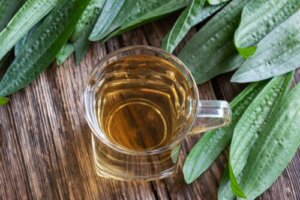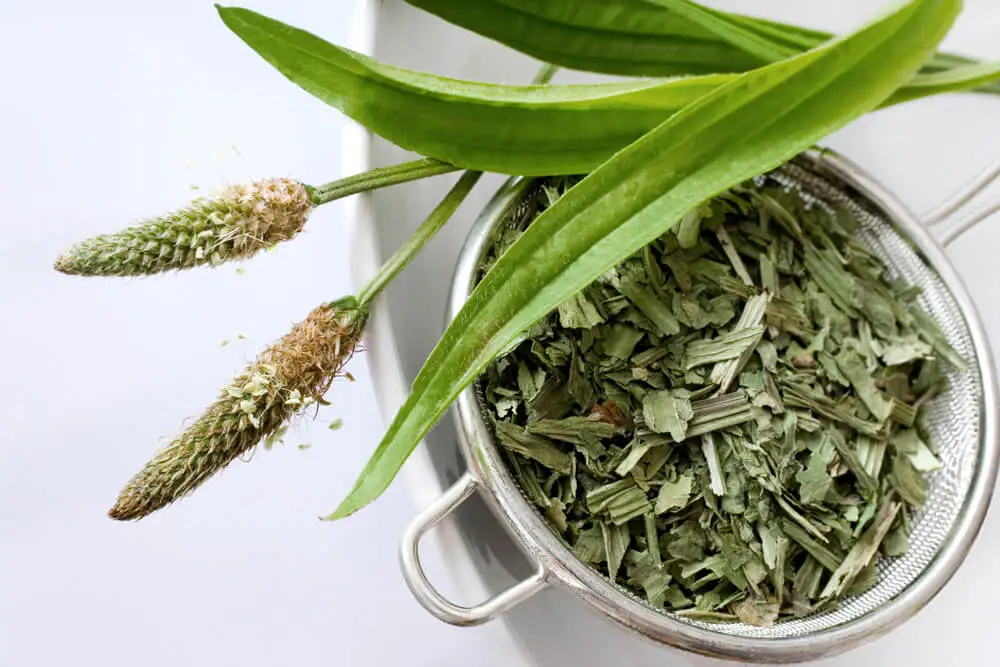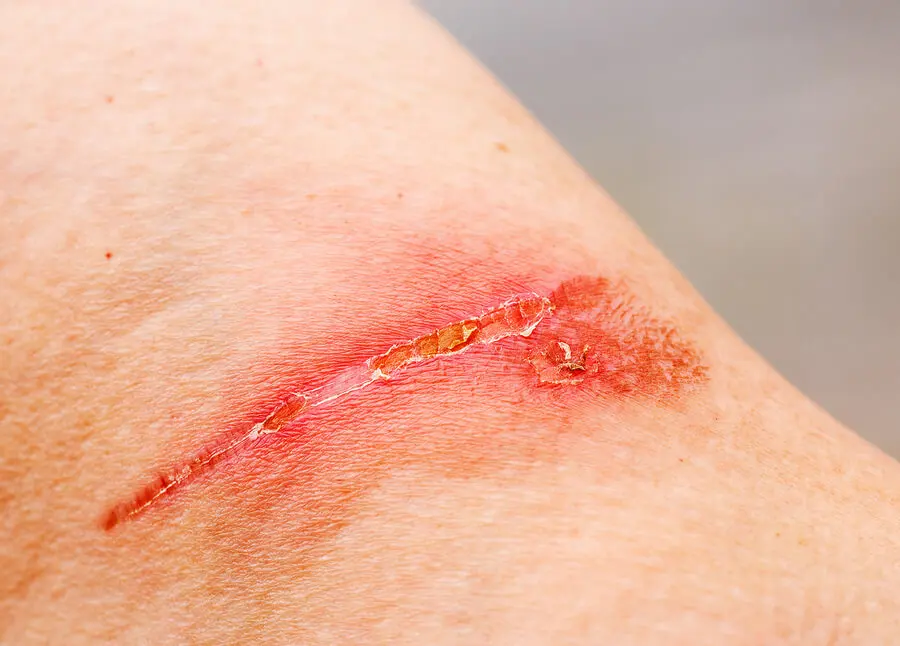Healing Properties of Plantain: What Does Science Say?

The healing properties of plantain are diverse: it helps in the recovery of colds, it’s healing, a gastric protector, is hypoglycemic, and contributes to kidney health, among many other benefits.
It’s considered rich in flavonoids and other compounds. In natural medicine, both its green leaves and seeds are used. It can be taken as an infusion and applied topically.
This plant is also consumed as food, in different recipes such as soups, stews, and purees. However, it should be used with caution during pregnancy. Do you know all the healing properties of plantain? Read on and find out more.
Healing properties of plantain
Plantain is a herbaceous species, also known as Plantago major, Plantago lanceolata, and broad-leafed plantain; it belongs to the Plantaginaceae family. It’s small, no more than twenty centimeters (8 inches) and has lanceolate, slightly toothed leaves. It’s often found in European and American countries, especially in humid environments.
Like many other plants, the curative properties of plantain have been the focus of different pieces of research. Thanks to this, there are now papers that support many of the medicinal benefits attributed to it. For example, a study published in Biomedicine and Pharmacotherapy determined that plantain contains:
- Flavonoids
- Alkaloids
- Terpenoids
- Phenolic acid derivatives
- Iridoid glycosides
- Fatty acids
- Polysaccharides
- Vitamins A, C, K
- Potassium citrate

Benefits of plantain
Due to the components of plantain, various healing properties are attributed to it, and so we can list a number of benefits that this plant provides to our health. However, we also need to clarify that it shouldn’t be considered a miraculous species, nor should it replace medical treatment.
In some cases, it could be a good adjuvant or complementary treatment. However, it’s advisable to consult a doctor before taking it, as it isn’t exempt from side effects or interacting with other medications.
1. Healing agent
According to the research cited above, plantain has positive effects as an adjuvant in the case of wounds, helping to heal and even acting as an anti-ulcerative agent.
Find out more: 6 Steps To Treat an Infected Wound
2. Flu and colds
Plantain is often used to fight common viral infections, such as flu and colds. According to research published in Antiviral Research, this is mainly due to its content of phenolic compounds, which have antiviral activity.
3. Other respiratory and oral conditions
Plantain leaf tea can be used to help thin and expel bronchial secretions. Also, gargling with this infusion relieves mouth and throat conditions, including tonsillitis and canker sores.
4. Protection against bacteria
Plantago major contains polysaccharide peptides, which have a high antibacterial activity, thus providing protective effects against Streptococcus pneumoniae, among other bacteria.
5. Liver health
Among the healing properties of plantain, positive effects against hepatotoxicity have also been found. A study published in the medical journal Indian Journal of Pharmacology found that the plant is anti-inflammatory and, in addition, hepatoprotective.
You may be interested in: 6 Diets that Help Care for Your Liver Health
6. Gastric ulcers
The leaves and seeds have been found to have gastroprotective functions, reducing the acidity of gastric juices and providing relief from heartburn. It may also inhibit Helicobacter Pylori activity.
7. Hypoglycemic
It’s believed that plantain may help control blood sugar levels by assisting in the processes taking place in pancreatic cells.
8. Diuretic
It may have a diuretic effect, and plantain tea may help reduce fluid retention, contributing to the treatment of urinary tract infections.
9. Contributes to kidney health
In the same vein, because of its anti-inflammatory and antioxidant properties, plantain also appears to help in the treatment of kidney stones. Specifically, it’s thought that it may prevent their growth.
According to a study published in the Malaysian Journal of Medical Sciences, extracts of this plant were superior to allopurinol and potassium citrate in inhibiting the size of a calcium oxalate crystal in vitro.
10. Treatment of burns
According to the results of an investigation (article in Spanish) in which the use of plantain in first-degree burns was analyzed, in the majority (75.9%) of patients, this treatment was favorable.
11. Premature aging
Being rich in antioxidants, plantain can prevent and repair damage caused by free radicals, preventing premature aging or decreasing the signs associated with it.
12. Other healing properties of plantain

According to research published in the Journal of Ethnopharmacology, there are other healing properties of plantain, as it’s also useful in the treatment of wounds:
- To treat boils and various skin diseases
- To decrease symptoms in circulation problems and hypertension
- To maintain stable blood sugar levels
- To prevent premature aging
- To decrease urine loss
How can plantain be taken?
Plantain tea is very easy to prepare:
- Boil some water and pour it into a cup
- Add a spoonful of green or dried leaves
- Cover and let it steep for ten minutes
- Strain and drink once or twice a day
With the fresh leaves you can prepare juice:
- Put a cup of cold water and two tablespoons of chopped leaves in a blender.
- Blend very well.
- Strain and drink it on an empty stomach.
Uses and applications
- It can be used topically or as a poultice. The plantain leaves are heated a little and then put on the affected parts, either by wounds, inflammations, ulcers, or insect bites.
- Its seeds are used in infusions as a complementary remedy against parasites.
- The infusion, in general, helps to reduce digestive discomfort such as diarrhea.
- Also, the peel is considered a remedy for constipation.
- When added to meals, it helps you enjoy all its properties.
Side effects of plantain
In general, there are no records of side effects of plantain administered orally in moderate amounts. However, its consumption is not recommended in pregnant or breastfeeding women.
Neither should it be administered to young children. Similarly, in cases of illness or other treatment, it’s best to consult a doctor to reduce the chances of an adverse reaction.
All cited sources were thoroughly reviewed by our team to ensure their quality, reliability, currency, and validity. The bibliography of this article was considered reliable and of academic or scientific accuracy.
- Abud M, Nardello A, Torti J (2017). Hypoglycemic Effect due to Insulin Stimulation with Plantago major in Wistar Rats. Med Aromat Plants (Los Angel), 6(3):292.
- Adom M, Taher M, Mutalabisin M, et al (2017). Chemical constituents and medical benefits of Plantago major. Biomedicine and Pharmacotherapy. Elsevier Masson SAS. Disponible en: https://doi.org/10.1016/j.biopha.2017.09.152
- Akbar, S. (2020). Plantago major L.(Plantaginaceae). In Handbook of 200 Medicinal Plants, 1455-1463.
- Ashkani-Esfahani S, Khoshneviszadeh M, Noorafshan A, et al (2019). The Healing Effect of Plantago Major and Aloe Vera Mixture in Excisional Full Thickness Skin Wounds: Stereological Study. World J Plast Surg, 8(1):51-57.
- Aziz S, See T, Khuay L, et al (2005). In vitro effects of plantago major extract on urolithiasis. The Malaysian Journal of Medical Sciences: MJMS, 12(2), 22–226. Disponible en: https://www.ncbi.nlm.nih.gov/pmc/articles/PMC3349397/
- Beara I, Lesjak M, Jovin E, et al (2009). Plantain (Plantago L.) species as novel sources of flavonoid antioxidants. Journal of Agricultural and Food Chemistry. Disponible en: https://doi.org/10.1021/jf902205m
- Beara I, Lesjak M, Orčić D (2012). Comparative analysis of phenolic profile, antioxidant, anti-inflammatory and cytotoxic activity of two closely-related Plantain species: Plantago altissima L. and Plantago lanceolata L. LWT – Food Science and Technology. Disponible en: https://doi.org/10.1016/j.lwt.2012.01.001
- Chathuranga K, Kim M, Lee H, et al (2019). Anti-Respiratory Syncytial Virus Activity of Plantago asiatica and Clerodendrum trichotomum Extracts In Vitro and In Vivo. Viruses, 3;11(7):604.
- Chiang L, Chiang W, Chang M, et al (2002). Antiviral activity of Plantago major extracts and related compounds in vitro. Antiviral Research, 55(1), 53–62. Disponible en: https://doi.org/10.1016/S0166-3542(02)00007-4
- Farokhi F, Khaneshi F. (2013). Histophatologic changes of lung in asthmatic male rats treated with hydro-alcoholic extract of Plantago major and theophylline. Avicenna J Phytomed, 3(2):143-51.
- Gomez R, Calderon C, Scheibel L, et al (2000). Immunoenhancing properties of Plantago major leaf extract. Phytother Res, 14(8):617-22.
- Hetland G, Samuelsen AB, Løvik M, Paulsen BS, Aaberge IS, Groeng EC, Michaelsen TE. Protective effect of Plantago major L. Pectin polysaccharide against systemic Streptococcus pneumoniae infection in mice. Scand J Immunol. 2000 Oct;52(4):348-55.
- Jazayeri S, Ghods R, Hashem D, et al (2021). The Efficacy of Plantago major Seed on Liver Enzymes in Nonalcoholic Fatty Liver Disease: A Randomized Double-Blind Clinical Trial. Evid Based Complement Alternat Med.
- Kartini, Piyaviriyakul S, Thongpraditchote S, et al (2017). Effects of Plantago major Extracts and Its Chemical Compounds on Proliferation of Cancer Cells and Cytokines Production of Lipopolysaccharide-activated THP-1 Macrophages. Pharmacogn Mag, 13(51):393-399.
- Keshavarzi A, Montaseri H, Akrami R, et al (2022). Therapeutic Efficacy of Great Plantain (Plantago major L.) in the Treatment of Second-Degree Burn Wounds: A Case-Control Study. Int J Clin Pract.
- Melese E, Asres K, Asad M, (2011). Evaluation of the antipeptic ulcer activity of the leaf extract of Plantago lanceolata L. in rodents. Phytother Res, 25(8):1174-80.
- Mello J, Gonzalez M, Moraes V, et al. (2015). Protective Effect of Plantago major Extract against t-BOOH-Induced Mitochondrial Oxidative Damage and Cytotoxicity. Molecules, 25;20(10):17747-59.
- Pinto J, Bustamante Z. (2008). Evaluación de la actividad gastroprotectora de los extractos de llantén (Plantago major). BIOFARBO, 16, 36-41. Disponible en: https://docs.bvsalud.org/biblioref/2019/07/1006607/evaluacion-de-la-actividad-gastroprotectora-de-los-extractos-d_cvQyxne.pdf
- Samuelsen A. (2000). The traditional uses, chemical constituents and biological activities of Plantago major L. A review. Journal of Ethnopharmacology. Disponible en: https://doi.org/10.1016/S0378-8741(00)00212-9
- Téllez G, Castaño J. (2010). Péptidos antimicrobianos. Infectio. 14(1), 55-67. Disponible en: https://pesquisa.bvsalud.org/portal/resource/pt/lil-560933
- Türel I, Ozbek H, Erten R, et al (2009). Hepatoprotective and anti-inflammatory activities of Plantago major L. Indian J Pharmacol 41(3):120–124. Disponible en: doi:10.4103/0253-7613.55211
- Wegener T, Kraft, K. (1999). [Plantain (Plantago lanceolata L.): anti-inflammatory action in upper respiratory tract infections]. Wiener Medizinische Wochenschrift (1946).
This text is provided for informational purposes only and does not replace consultation with a professional. If in doubt, consult your specialist.








